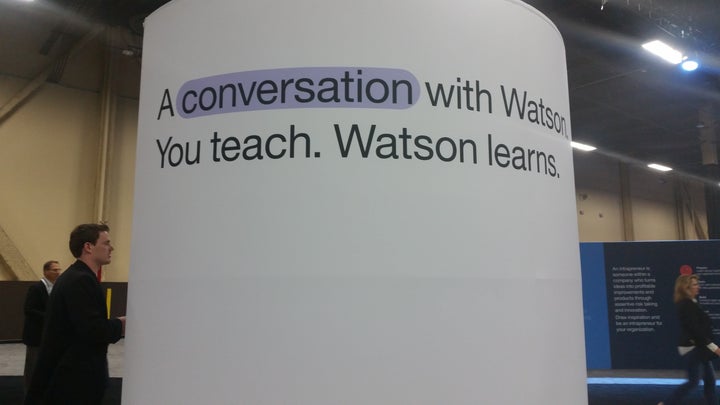
They say what happens in Vegas stays in Vegas, but I keep telling everyone I know about the remarkable innovations I saw at IBM World of Watson 2016 conference, held from Oct. 24 to 27 at beautiful Mandalay Bay, where I was among the 17,000 attendees. As I was “welcomed to the World of Watson,” I learned that Watson (yes, the computer that was on Jeopardy) is IBM’s researchers’ vision “to design an intelligent system that brings man and machine together to create a better world.” If that sounds like a utopian fantasy, prepare to be amazed at how real that vision has become: Watson is changing how doctors cure disease, how companies analyze their social media footprints, and how financial services firms adapt to ever-changing regulations. I could write an entire book on all that Watson has to offer, but my focus here is on Watson’s ability to help financial services firms meet compliance demands more efficiently and with less cost – a much needed innovation as firms spend $99 billion on addressing compliance, thus limiting their ability to invest in growth, according to Marc Andrews, VP of Industry Analytics Solutions for IBM.
If you’re scratching your head at why regulatory compliance costs are so high, picture this: Linda, a trader at a high-profile brokerage firm, receives a bad performance review from her supervisor. Upset and fed up with her employer, she throws compliance by the wayside and decides to “pump and dump” a microcap pharmaceutical security with the hope of making a great deal of cash before quitting her job. To set the wheels in motion, she emails some fellow traders at her company and starts hyping up the security, telling them that she received a “big tip” from “someone in the know” that the company soon would be receiving FDA approval on a promising new drug so the stock price will be going through the roof. If Linda’s plan succeeds, the results very likely would be a compliance nightmare for her company, as sanctions and fines cost financial services firms $250 billion annually, according to Andrews.
However, fortunately for Linda’s employer, compliance officers at the firm stop Linda’s plan after she sends out her first few emails. This may sound like a superhuman feat, like the compliance officers should be wearing capes and spandex suits with a “C” on them. However, all they did was log into their IBM Surveillance Insight for Financial Services dashboard, which identified Linda as a potential compliance risk. IBM Surveillance Insight is a “cognitive surveillance engine” in that it uses the power of Watson to contextualize seemingly disparate signals. In other words, it can take in and piece together unstructured data – such as employee email, chat transcripts, and voice calls – as well as structured data such as trade transactions, in order to create a more thorough surveillance system.
If this all sounds just a little farfetched to you, consider this: Our brains piece together apparently unrelated information constantly, oftentimes to our benefit. For example, when driving down a busy highway in the rain, your brain may combine the observation that it is raining with previously learned advice on the dangers of driving on slick roads and safe-distance driving techniques, as well as real-time observations on the activities of other drivers on the road. This all occurs simultaneously and instantly, probably without conscious thought, resulting in the hyper-awareness that allows you to stop and not skid into the car in front of you when the driver stops short. In other words, your brain proactively recognized triggers and associated risk and took action to avoid danger before you slammed on your brakes and it was too late to avoid rear-ending another car.
IBM Surveillance Insight is able to identify compliance threats precisely because it analyzes human behavior in a way that mimics human reasoning such as the scenario above. For compliance officers, mitigating risk at their companies often can feel like driving on an oil-slicked road in a minefield in the dark, with only one working headlight; it’s difficult to see the risks and even harder to avoid them. In fact, the shortcoming of traditional compliance surveillance systems is that they take in and only react to structured data such as trades. To be sure, this is better than no surveillance at all, but it is still only part of the picture, leaving compliance officers partially in the dark. It’s no wonder that, according to a 2012 trade group survey, 60% of compliance officers have considered calling it quits because of job stress.
And as regulations continue to increase, the pressure on compliance officers will become even higher, increasing the need for firms to invest in technology that aids in compliance. IBM Surveillance Insight is one option; another is Salesforce Shield, which consists of compliance features that Salesforce added to its client relationship management software to help firms contend with the Depart of Labor’s new fiduciary rule.
Now, let’s be honest here. Computers will never render flesh-and-blood compliance officers obsolete. As good as Watson’s cognitive capabilities are, Watson is no replacement for a human taking a final look at the gathered data and determining whether employee behavior truly violated regulations. And yet, by aiding compliance officers’ efforts to find fraudulent trades, artificial intelligence can not only make compliance workers’ jobs easier but also make the financial services industry safer for investors. After all, it is investors who ultimately suffer the most when financial services firms fail to comply with the regulations designed to keep them safe. Just consider the 4,000 investors who lost their money to Nicholas Cosmo, totaling more than $195 million, and the 300 or so investors who lost a total of $5.3 million to Christopher Bass as part of a Ponzi scheme.
As financial services professionals, we owe it to investors to find and utilize new technologies that can help stop schemes like the ones above in their tracks. Compliance is not merely a matter of keeping regulators happy; it is at its core our duty in keeping investors safe. You wouldn’t want your pilot flying without airline computers and electronic control systems; likewise, investors don’t want their financial services firms keeping them safe with dinosaur compliance procedures. That’s where Watson comes in. Watson has learned quite a bit since its appearance on Jeopardy five years ago; I can only imagine the innovations that will develop over the next year. I already have the 2017 World of Watson Conference inked into my calendar for Oct. 29 to Nov. 2, also in Las Vegas. It’s never too early to book that plane ticket.
